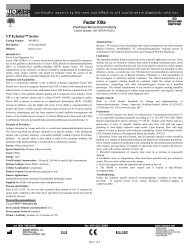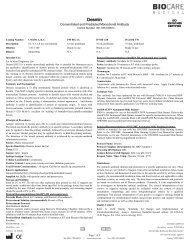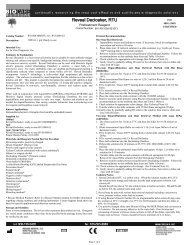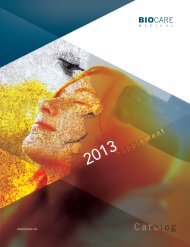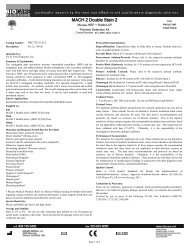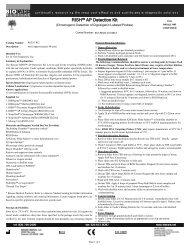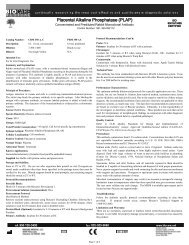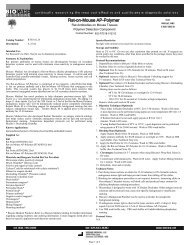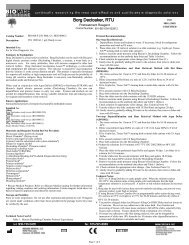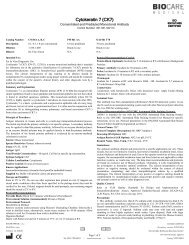Data Sheet - Biocare Medical
Data Sheet - Biocare Medical
Data Sheet - Biocare Medical
You also want an ePaper? Increase the reach of your titles
YUMPU automatically turns print PDFs into web optimized ePapers that Google loves.
TrekAvidin-AP Label<br />
Conjugated Streptavidin Alkaline Phosphatase<br />
Detection Component<br />
Control Number: 901-STALP700-102510<br />
ISO<br />
9001:2000<br />
CERTIFIED<br />
Catalog Number:<br />
Description:<br />
Intended Use:<br />
For In Vitro Diagnostic Use<br />
STALP700 L10<br />
110 ml<br />
Summary & Explanation:<br />
TrekAvidin (streptavidin) is a protein that has similar binding properties to egg white<br />
avidin. It is isolated from streptomyces avidinii. Streptavidin has a molecular weight<br />
of 60 kDa and has 4 subunits. Each subunit can bind one molecule of biotin. Biotin is<br />
a water-soluble vitamin. Streptavidin has an extremely high binding affinity (Kd=10<br />
-15) for biotin. Streptavidin conjugated to alkaline phosphatase has proven useful in<br />
the detection of antigens coupled with biotinylated secondary antibodies.<br />
There are several advantages when using a streptavidin-conjugate versus an ABC<br />
complex. In contrast to avidin, streptavidin is not glycosylated and is therefore<br />
uncharged at neutral pH (6.5 versus 10). This lowers nonspecific background staining.<br />
Streptavidin also lacks carbohydrate side chains that may be another cause of nonspecific<br />
background.<br />
Streptavidin-ALP is much more stable than the ABC complex. The ABC complex<br />
must be freshly made 30 minutes prior to use, and is stable only for a few days. In<br />
contrast, the Streptavidin-ALP reagent is very stable, color-coded and can be stored for<br />
1 year. <strong>Biocare</strong>’s Streptavidin-ALP comes in a ready-to-use format, thus saving time<br />
and potential mistakes.<br />
The TrekAvidin-ALP is part of <strong>Biocare</strong>’s Starr Trek detection system. It is extremely<br />
cost effective and can be used with <strong>Biocare</strong>’s, BioGenex’s or Dako’s concentrates and<br />
prediluted antibodies.<br />
Known Applications:<br />
Immunohistochemistry (formalin-fixed paraffin-embedded tissues)<br />
Supplied As:<br />
Alkaline phosphatase-conjugated streptavidin is diluted in TBS with protein carrier and<br />
preservative (sodium azide free)<br />
Materials and Reagents Needed But Not Provided:<br />
Microscope slides, positively charged<br />
Desert chamber* (Drying oven)<br />
Positive and negative tissue controls<br />
Xylene (Could be replaced with a xylene substitute*)<br />
Ethanol or reagent alcohol<br />
Decloaking chamber* (Pressure cooker)<br />
Deionized or distilled water<br />
Wash buffer*(TBS/PBS)<br />
Pretreatment Reagents*<br />
Enzyme Digestion*<br />
Avidin-Biotin Blocking Kit* (Labeled Streptavidin Kits Only)<br />
Peroxidase block*<br />
Protein block*<br />
Primary antibody*<br />
Negative Control Reagents*<br />
Chromogens*<br />
Hematoxylin*<br />
Bluing Reagent*<br />
Mounting media*<br />
* <strong>Biocare</strong> <strong>Medical</strong> Products: Refer to a <strong>Biocare</strong> <strong>Medical</strong> catalog for further information<br />
regarding catalog numbers and ordering information. Certain reagents listed above are<br />
based on specific application and detection system used.<br />
Species Reactivity:<br />
N/A<br />
Storage and Stability:<br />
Store at 2ºC to 8ºC. Do not use after expiration date printed on vial. If reagents are<br />
stored under conditions other than those specified in the package insert, they must be<br />
verified by the user.<br />
Protocol Recommendations:<br />
Deparaffinization:<br />
Deparaffinize slides in Slide Brite or xylene. Hydrate slides in a series of graded<br />
alcohol to water.<br />
Peroxide Block:<br />
Block for 5 minutes with <strong>Biocare</strong>'s Peroxidazed 1.<br />
Pretreatment Solution/Protocol:<br />
Please refer to the respective primary antibody datasheet for recommended<br />
pretreatment solution and protocol.<br />
Protein Block:<br />
Incubate for 10-15 minutes at RT with <strong>Biocare</strong>'s Background Sniper.<br />
Primary Antibody:<br />
Please refer to the respective primary antibody datasheet for incubation time.<br />
Link:<br />
Incubate for 20 minutes at RT with Trekkie Link.<br />
Label:<br />
Incubate for 10 minutes at RT with Trekavidin-AP Label.<br />
Chromogen:<br />
Incubate for 10-20 minutes at RT when using <strong>Biocare</strong>'s Vulcan Fast Red.<br />
Counterstain:<br />
Rinse with deionized water. Incubate for 30-60 seconds with Tacha's Automated<br />
Hematoxylin. Rinse with deionized water. Apply Tacha's Bluing solution for 1 minute.<br />
Technical Notes:<br />
1. A hydrogen peroxide blocking solution may be used to bleach red blood cells.<br />
Apply before pretreatment protocols and/or before the blocking serum step. It will<br />
have no affect on the alkaline phosphatase system.<br />
2. Use TBS for washing steps.. Do not use PBS wash buffers with alkaline phosphatase<br />
systems.<br />
Protocol Notes:<br />
The optimum antibody dilution and protocols for a specific application can vary due to<br />
many factors. These include, but are not limited to: fixation, incubation times, tissue<br />
section thickness and detection kit used. The data sheet’s recommendations and<br />
protocols are based on exclusive use of <strong>Biocare</strong> products. Due to the superior<br />
sensitivity of these unique reagents, the recommended incubation times and titers listed<br />
are not applicable to other detection systems, as results may vary. Ultimately, it is the<br />
responsibility of the investigator to determine optimal conditions.<br />
Performance Characteristics:<br />
The protocols for a specific application can vary. These include, but are not limited to:<br />
fixation, heat-retrieval method, incubation times, tissue section thickness and detection<br />
kit used. Due to the superior sensitivity of these unique reagents, the recommended<br />
incubation times and titers listed are not applicable to other detection systems, as<br />
results may vary. The data sheet recommendations and protocols are based on<br />
exclusive use of <strong>Biocare</strong> products. Ultimately, it is the responsibility of the<br />
investigator to determine optimal conditions. These products are tools that can be used<br />
for interpretation of morphological findings in conjunction with other diagnostic tests<br />
and pertinent clinical data by a qualified pathologist.<br />
Quality Control:<br />
Refer to NCCLS Quality Assurance for Immunocytochemistry approved guidelines,<br />
December 1999 MM4-A Vol.19 No.26 for more information on tissue controls.<br />
Page 1 of 2
TrekAvidin-AP Label<br />
Conjugated Streptavidin Alkaline Phosphatase<br />
Detection Component<br />
Control Number: 901-STALP700-102510<br />
ISO<br />
9001:2000<br />
CERTIFIED<br />
Precautions:<br />
Reagents contain less than 0.1% Sodium azide. Concentration less than 0.1% is not<br />
reportable hazardous material according to U.S. 29 CFR 1910.1200, OSHA Hazard<br />
communication and EC Directive 91/155/EC.<br />
Sodium azide (NaN3) used as a preservative is toxic if ingested. Sodium azide may<br />
react with lead and copper plumbing to form highly explosive metal azides. Upon<br />
disposal, flush with large volumes of water to prevent azide build-up in plumbing.<br />
(Center of Disease Control, 1976, National Institute or Occupational Safety and health,<br />
1976).<br />
Specimens, before and after fixation, and all materials exposed to them should be<br />
handled as if capable of transmitting infection and disposed of with proper precautions.<br />
Never pipette reagents by mouth and avoid contacting the skin and mucous membranes<br />
with reagents and specimens. If reagents or specimens come in contact with sensitive<br />
areas, wash with copious amounts of water.<br />
Microbial contamination of reagents may result in an increase in nonspecific staining.<br />
Incubation times or temperatures other than those specified may give erroneous results.<br />
The user must validate any such change. The MSDS is available upon request.<br />
Troubleshooting:<br />
Follow the reagent specific protocol recommendations according to data sheet<br />
provided. If atypical results occur, contact <strong>Biocare</strong>'s Technical Support at 1-800-542<br />
-2002.<br />
Limitations & Warranty:<br />
There are no warranties, expressed or implied, which extend beyond this description.<br />
<strong>Biocare</strong> is not liable for property damage, personal injury, or economic loss caused by<br />
this product.<br />
Page 2 of 2



